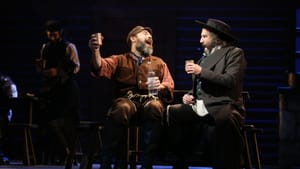Stay in the Loop
BSR publishes on a weekly schedule, with an email newsletter every Wednesday and Thursday morning. There’s no paywall, and subscribing is always free.
Tevye returns
Bartlett Sher's 'Fiddler on the Roof' on Broadway

Sitting in the Broadway Theatre at Bartlett Sher’s thrilling revival of Fiddler on the Roof, I thought I was watching a mural by Marc Chagall come alive.
Familiar images of the shtetl swirl before our eyes: the bride and groom in each other’s arms, the figure dragging the cart, the men in prayer shawls, the women in scarves — all whirl around the enigmatic fiddler who leads them from a past rooted in tradition into an uncertain, unsettling future.
One of Broadway’s longest running musicals, Fiddler has enjoyed numerous revivals since its 1964 premiere, which starred the immortal Zero Mostel as Tevye, reluctant hero of Sholem Aleichem’s short story about a poor milkman and his five daughters in Tsarist’s Russia’s “Pale of Settlement” at the turn of the 20th century. The current production benefits from director Sher’s inspired treatment of this touching tale of Tevye’s struggle to maintain tradition in the face of historical change.
Spectacle, with grace
Sher is not only an established and estimable stage director (The King and I, South Pacific, both at Lincoln Center), but he is also an experienced director of opera (The Barber of Seville, Otello, L’Elisir d’Amore, and others at the Metropolitan Opera House). As such, he knows how to work in huge spaces and move large casts and complex scenery around the stage with grace and fluidity.
He brings these skills to Fiddler, along with an inspired design team. The houses of the tiny village of Anatevka float over an empty stage as in a fairy tale, and set elements fly in and out effortlessly. A hut, a flowering tree, a table, and chair appear here and there, and presto — the world of the shtetl is evoked. Occasionally a delicate mural of burnished bronze floats down over the bare brick backstage wall, as during the wedding scene of Tevye’s eldest daughter (to “Sunrise, Sunset”).

The program credits Jerome Robbins (of the original) with its inspiration for the choreography, but here Hofesh Shechter gives it a striking new style and innovative interpretation. The nightmare dance sequence in “Tevye’s Dream” features fabulous masks and colorful costumes by Catherine Zuber and scary figures on stilts. With this inspired combination of direction, design, and movement — together with those wonderful well-known melodies — Sher’s production is airborne.
A “ya ba dibba” of his own
Comparisons are inevitable with past Tevyes, who include Mostel, Chaim Topol, Alfred Molina, Harvey Fierstein, and Henry Goodman. In this revival, Danny Burstein brings his own low-key, self-deprecating charm and genuineness to the role. His “shimmying” moves in “If I Were a Rich Man” may be reminiscent of Mostel, but his “ya ba dibba” is completely his own (I couldn’t begin to replicate it here, but it’s a delightful Yiddish-sounding improvisation).
He delivers Tevye’s one-liners (e.g., “Today I am a horse”) with tongue-in-cheek relish. As one by one his eldest three daughters defy tradition and marry for love (rendering Yente, the matchmaker, obsolete), Tevye delivers his salty asides to the audience. “On the other hand,” he says, as he rationalizes the decline of tradition and his need to adapt to the inevitable changes, both personal and political.

As his daughters leave him — and as the threat of a pogrom and expulsion from Anatevka looms — Tevye's running conversation with God is reminiscent of Job’s. “We’re the chosen people — but once in a while, can’t you choose someone else?” he says. The light touch of his delivery renders the pain both piercing and poignant. I’m not ashamed to report that I teared up numerous times throughout the performance (“Tradition,” “Sabbath Prayer,” “Far Fom the Home I Love”) — and I was not alone.
A vision of Jewish history
Burstein’s performance is supported by a stellar company, including Jessica Hecht as a sharp-tongued Golde, Alexandra Silber as a strong-willed Tzeitel (daughter #1), and Samantha Massell as a beautiful-voiced Hodel (daughter #2), as well as their respective suitors: Adam Kantor as the timid tailor Motel and Ben Rappaport as the revolutionary student Perchik.
In the final tableau, when the Jews are driven from their beloved Anatevka to begin their separate journeys (to America, the Holy Land, and elsewhere), Sher directs his company to fall in line behind the sprightly Fiddler (Jesse Kovarsky). Instead of leading them toward a destination, however, he moves them around in a circle that continues to turn as the lights fade. It’s a stunning vision of Jewish history: past, present, and (ominous) future.
What, When, Where
Fiddler on the Roof. Bartlett Sher directed. Book by Joseph Stein based on a short story by Sholem Aleichem. Music by Jerry Bock; lyrics by Sheldon Harnick. Through July 3, 2016 at Broadway Theatre, 1681 Broadway, New York. fiddlermusical.com
Sign up for our newsletter
All of the week's new articles, all in one place. Sign up for the free weekly BSR newsletters, and don't miss a conversation.
